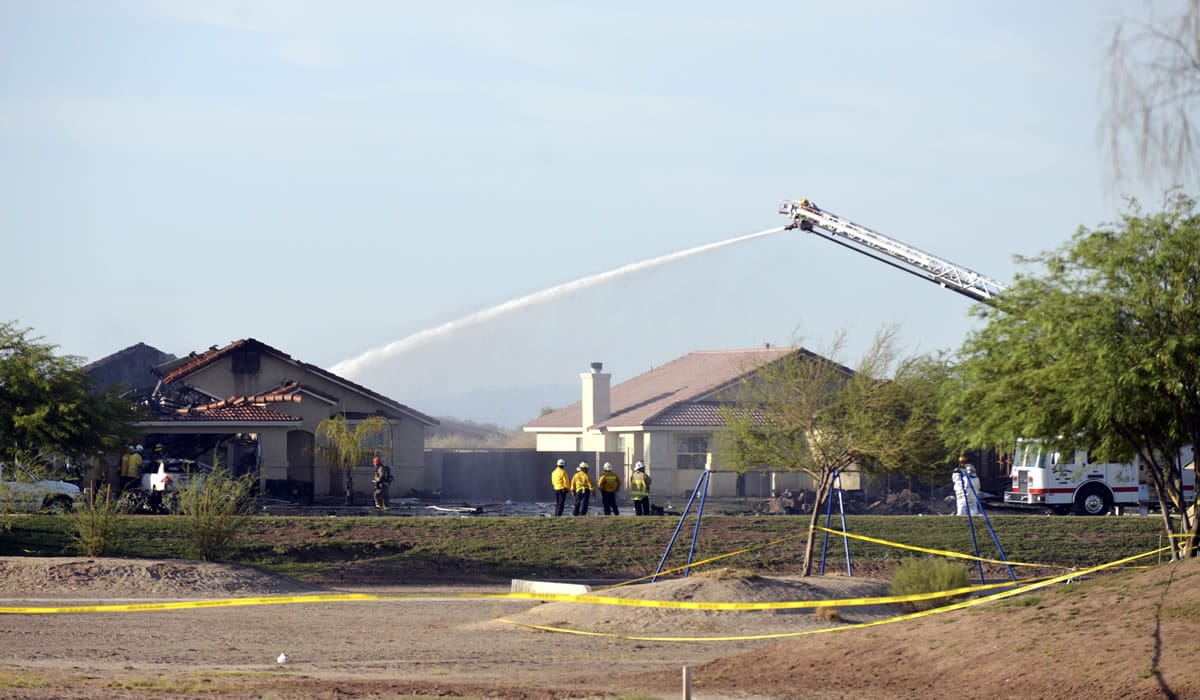IMPERIAL, Calif. — The Marine Corps was cleaning up a Southern California neighborhood on Thursday and working to help families whose homes were damaged or destroyed by one of its jets that crashed in the small desert city of Imperial, officials said.
The Harrier AV-8B had taken off from the Marine Corps Air Station in Yuma and was almost at his destination at Naval Air Facility El Centro when it went down Wednesday afternoon, exploding into flames. The pilot who was ejected landed in a nearby field and suffered only scrapes and bruises. There were no injuries in the neighborhood.
Two homes were destroyed and a third suffered major damage in a newer neighborhood of Imperial, a city of about 15,000 people about 90 miles east of San Diego.
Two of the families went to stay with friends or relatives while the Red Cross put up one couple in a hotel. Officials were assessing whether any of the families would need longer term help, such as rental assistance or other items, said Red Cross spokeswoman Courtney Pendleton.
Marine Capt. Anton Semelroth said the military was working with city and Red Cross officials.
“We’ve reached out to folks to make sure they’re being taken care of now and will continue to work with them to make sure we are doing the right thing,” Semelroth said.
Marine Corps officials were cleaning up the crash site and had launched an investigation, Semelroth said. However, it could take months to determine whether human error, a mechanical failure or some other reason caused the jet to crash.
Eleven-year-old Christopher Garcia was watching TV with his father and brother when he heard a frightening boom. Outside, he said, he saw a pilot in a parachute falling from the sky and what looked like a mushroom cloud of dark smoke two blocks away. He ran to the crash scene to find one house with a collapsed roof, the neighboring house on fire, and a crying woman shouting, “‘That’s my house!'” The boy and other witnesses said panicked neighbors were running in every direction.
Debris from the Harrier jet hit the roof of one of the houses, which was destroyed, Marine Lt Col John Ferguson said.
It was the second crash in a month of a Harrier jet from the Yuma air base.
On May 9, a pilot was able to eject safely before his jet crashed in a remote desert area near the Gila River Indian Community, south of Phoenix. No one was injured.
In July 2012, another AV-8B Harrier crashed in an unpopulated area 15 miles from the air base, which is among the busiest in the world for the Marine Corps, and is used it to train military aviators from around the nation.
“Every time we take off, safety is our biggest concern,” Semelroth said. “I’m sure after the previous mishaps we’ve got a better process now and will take this investigation and do the same thing. We constantly try to improve the process and make it safer.”
A few hours after the jet crashed in Imperial, a Navy Hornet went into the sea off San Diego as it prepared to make a late-night landing on an aircraft carrier. The pilot was ejected and listed in stable condition.



